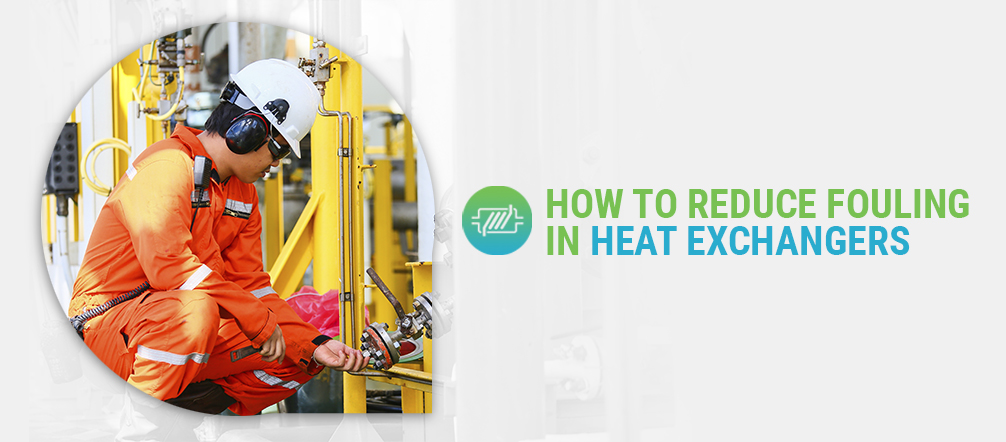
Your heat exchanger works hard to keep your boiler or cooling tower performing effectively. But at some point, even a high-quality heat exchanger will likely become fouled because of minerals or other small particles in your water.
How do you get rid of fouling in heat exchangers? Minimizing fouling is quick and easy, and we’ll show you how in the guide below.
Heat exchanger fouling is the deposit of undesirable materials on a heat exchanger’s internal heat transfer surfaces. These unwanted materials include:
This accumulation of materials causes fluid flow and heat transfer resistance, which decreases the pressure while reducing the heat exchanger’s efficiency and can lead to poor performance.
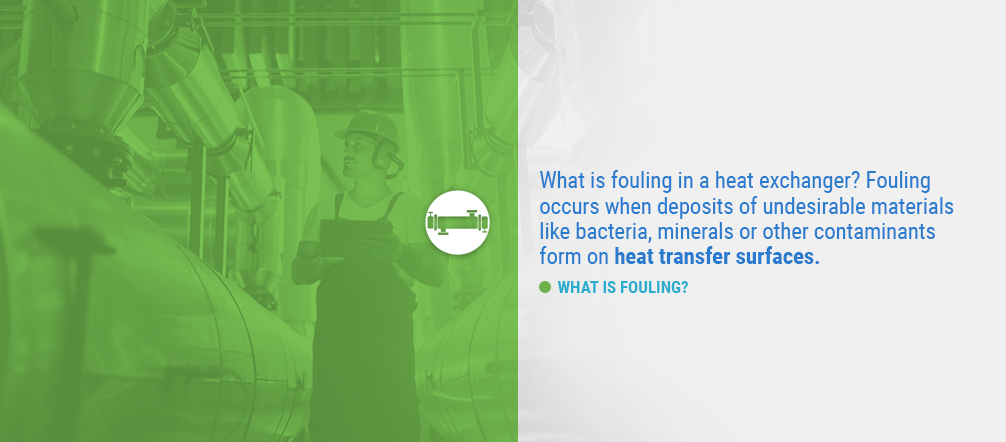
There are many types of fouling in a heat exchanger, including:
Scaling, also known as crystallization fouling, is particularly common, especially in systems involving water. Scaling occurs when minerals in the water precipitate and collect on the heat exchanger’s surfaces as crystals, forming a whitish buildup. This type of fouling is caused by silicates, calcium sulfate and calcium carbonate.
Particulate fouling — incrustation — occurs when small particles of matter collect on the heat exchanger’s surfaces, forming a crust or coating. The particulates are sometimes tiny, less than a nanometer in diameter, though they may be larger. Particulate fouling may occur in both gas and liquid systems.
Corrosion fouling occurs when impurities in the water change the composition of the heat exchanger’s metal surfaces, degrading the metal and often making it structurally unsound. Corrosion occurs because although refined metals like steel are strong and sturdy, they are not as chemically stable as other substances. Chemical reactions between the metals and the surrounding environment slowly turn the surfaces of these metals into more chemically stable, if weaker, forms, including oxides and sulfides.
Biological fouling is common in wastewater treatment applications, but it can occur in many operations that involve water. Biological fouling occurs when microbes like bacteria, protozoa and nematodes settle and form a biofilm or sludge on equipment surfaces. It is a particular concern in food processing applications where safe, sanitary products are essential, and the potential for biological contamination is high.
Chemical fouling occurs when a chemical reaction takes place near the surface of a heat exchanger. If chemicals are present in the water, the heat of the process water as it passes through the heat exchanger can speed up the reactions and leave unwanted surface deposits.
Freezing fouling most often takes place with chilling operations. It occurs when a liquid freezes at a surface and the frozen layer impedes heat transfer.
Sediment fouling comes from corrosion products, like alumina, silt and metal oxides, as well as diatomic organisms like microalgae and their excrement.
Fouling often occurs because of the water composition in the system. Many variables contribute to the overall fouling process. The common causes leading to heat exchanger fouling include:
These variables can be expressed as a fouling factor — a figure that numerically represents heat transfer resistance. They form a fouling layer that decreases pressure while increasing thermal resistance.
Fouling reduces the amount of heat exchange that can take place. This reduced heat exchange leads to a host of other issues. The consequences of fouling heat exchangers include:
In cases of severe fouling, the heat exchanger can become blocked and fail prematurely. Some fouling deposits can cause corrosion, shortening the exchanger’s working life.
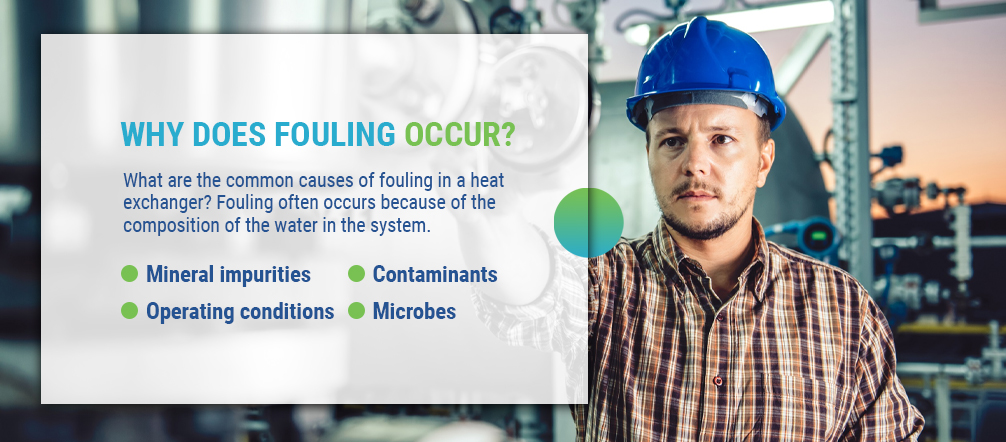
Fouling can also increase expenses by making your heat exchanger less efficient. When your heat exchanger works less efficiently, it consumes much more power to do the same amount of heating, so you’ll likely see an increase in your utility bills if your heat exchanger becomes fouled.
Other costs of fouling include:
Fouling causes problems with water flow. Fouling is generally rougher than the smooth surfaces of metal components and pipes, impeding the movement of water. Blocked water flow can cause inefficiencies and pressure drops and diminish the heat exchanger’s performance overall.
One of the main commercial consequences of fouling is dramatically increased maintenance costs. Because buildup on your heat exchanger’s surfaces tends to accelerate the rate of degradation, the heat exchanger will likely require more frequent cleanings and more extensive and costly repairs.
Fouling can also increase expenses by making your heat exchanger less efficient. When your heat exchanger works less efficiently, it consumes much more power to do the same amount of heating, so you’ll likely see an increase in your utility bills if your heat exchanger becomes fouled.
Other costs of fouling include:
If you want to detect the level of fouling on your heat exchanger, you can do so by monitoring system performance or physically inspecting the system. Methods to detect fouling in heat exchangers include:
Research on fouling often involves experimental studies or simulators. More direct research on fouling samples and different types of heat exchangers is likely necessary.
You can detect fouling using instruments designed to measure and report critical variables, including:
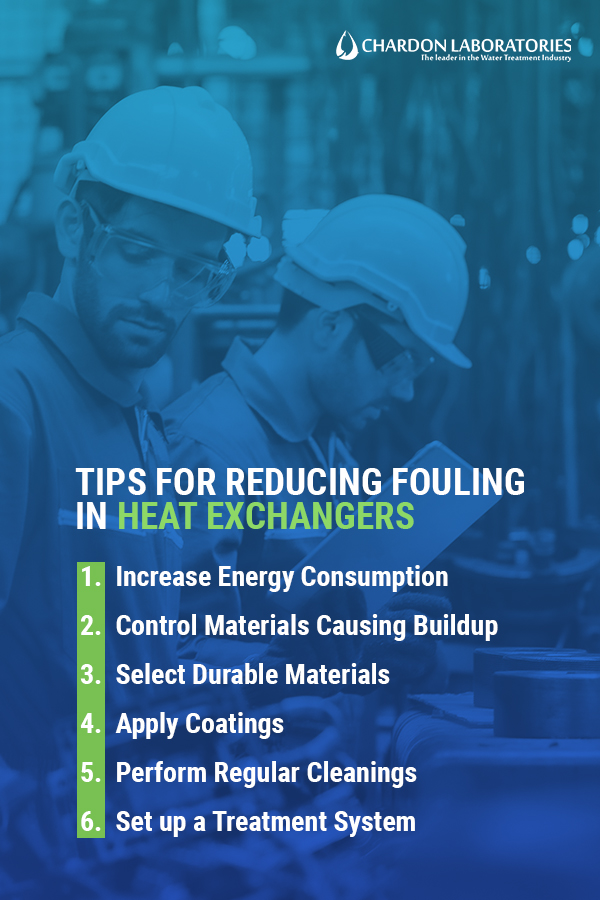
Keeping your heat exchanger free from fouling is essential for its longevity, efficiency, cost-effectiveness and overall performance. Improving fouling resistance involves paying attention to the heat exchanger’s port filtration, back-flushing, constant flow and material surfaces. Below are some practical strategies for how to reduce fouling in heat exchangers:
Though increasing your energy consumption isn’t always in your facility’s best environmental or budgetary interests, it can help reduce fouling in your heat exchanger. If you increase your energy consumption so that your heat exchanger operates at peak intensity, the increased turbulence may mean the contaminants in the feedwater do not have a chance to settle. However, this method of fouling reduction is expensive and wasteful, and it’s not always effective.
If you have a choice in the water you use in your heat exchanger, you can try to choose softer water that contains fewer impurities. You can also try to filter out impurities, including microbiological contaminants, that would cause buildup. Even though systems like boiler systems are so hot they rarely provide ideal breeding grounds for bacteria, microbes may be a significant concern in some heat exchanger applications like cooling towers.
However, filtration and purification systems are expensive. They are sometimes feasible on smaller scales, but they are rarely practical for large-scale commercial and industrial applications.
Selecting resistant materials for your heat exchanger can help reduce fouling. Generally, when you have the option, you’ll want to choose materials that are hygienic, durable and long-lasting and exhibit the thermal characteristics you need for effective heat transfer.
For example, even though carbon steel is cheaper and easier to work with than stainless steel, it is also more brittle and much more susceptible to corrosion. Choosing stainless steel for your applications can help your heat exchanger resist fouling, maintain its optimal performance and last much longer.
Using scraped-surface or corrugated-tube heat exchangers can also decrease fouling. Because of their rough surfaces, these designs increase turbulence in the water, and the turbulence prevents solids from settling.
However, when you choose materials for their fouling resistance, this can have a few drawbacks. Certain materials can deter fouling, but they are not always 100% effective. They are also likely to be more expensive than traditional options.
Applying protective coatings to your heat exchanger surfaces can prevent foulant adhesion and adsorption and inhibit fouling. Inert coatings are useful because they prevent the base metal from interacting with substances in the water that cause fouling. Synthetic fluoropolymers like polytetrafluoroethylene (PTFE) and perfluoropolyether (PFPE) are common coating materials because of their hydrophobic and nonstick properties, high thermal stability and chemical inertness.
Protective fouling-resistant coatings are flexible and effective. If you already have plans to upgrade your equipment, purchasing a new heat exchanger that features these coatings is an excellent strategy. However, if you’re happy with your current heat exchanger and merely want to reduce fouling in an existing system, retrofitting the surfaces with coatings may not be practical logistically. Certain coatings also cannot stand up to high temperatures or extreme abrasion and will wear down under these conditions.
Cleaning heat exchangers on a regular basis can remove existing fouling and reduce further fouling in the future to keep the equipment operating efficiently. Cleaning scale from a heat exchanger, in particular, removes mineral deposits to improve performance and decrease operational costs.
To clean scale from a heat exchanger, you can follow a series of simple steps:
One of the most effective products for scale removal is called Scalzo. Scalzo contains hydrochloric acid to dissolve mineral deposits. It also contains special corrosion inhibitors and dispersants to help a heat exchanger’s surfaces resist fouling even after cleaning is complete.
However, because it is so caustic, hydrochloric acid is not suitable for use with stainless steel. It causes pitting, a more severe and localized form of corrosion that leaves large depressions in the metal. For stainless steel heat exchanger components, you’ll want to use a product like CA-100, which contains citric acid instead of hydrochloric acid. It is gentler on stainless steel while still providing effective scale cleaning.
One of the most effective steps you can take to reduce fouling in your heat exchanger is to set up a regular treatment plan. Partner with a reliable water treatment company like Chardon Labs for quality chemical treatment. When you work with a professional company for industrial water treatment services, you’ll save valuable time and gain peace of mind of knowing your heat exchanger is in expert hands.
Chardon Labs can deliver the chemicals, treat your water and dispose of these substances for you so you can continue focusing on your facility’s most pressing needs.
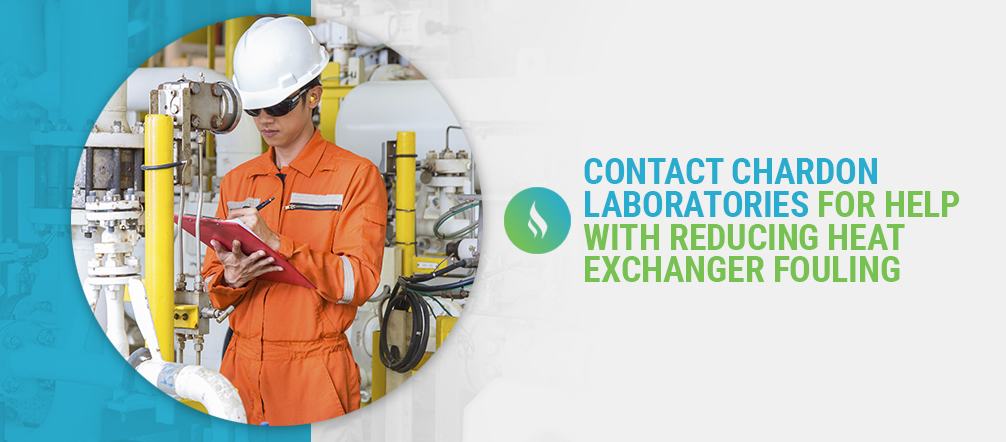
Chardon Labs can deliver the chemicals, treat your water and dispose of these substances for you, so you can continue focusing on your facility’s most pressing needs.
Fouling reduces efficiency, impedes performance and increases the frequency of expensive, time-consuming maintenance and repairs. Fortunately, working with water treatment professionals to reduce fouling can improve your heat exchanger’s performance, which helps your equipment last longer and perform better. You’ll diminish your utility bills and make your operations more cost-effective overall.
At Chardon Labs, we can provide you with essential chemical treatments at a fixed price that works for your budget. We are also happy to work with you on a custom treatment plan that fits your facility’s unique needs.
Contact us today to learn more.